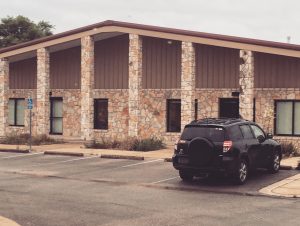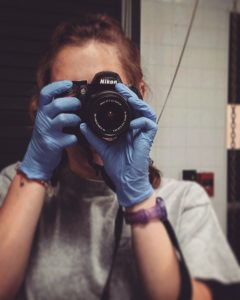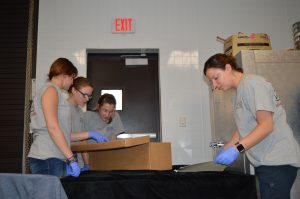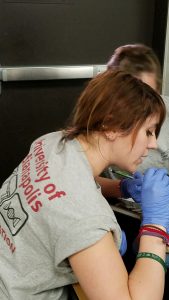This morning, the team awoke for a warm breakfast made by Dr. Latham. We had breakfast tacos and potatoes, and they were wonderful! We knew today would be a long day at the Osteology Research and Processing Lab (ORPL) so we needed full stomachs to fuel us for the day. ORPL is located on 26 acres of the Freeman Ranch and opened in 2008. ORPL is part of a larger multi-purpose facility that is used for teaching and training purposes, as well as for conferences and outreach services. Specifically, ORPL is utilized for forensic anthropological casework as well as the processing of skeletons donated to the Texas State Donated Skeletal collection. ORPL is where the skeletal analysis portion of this trip takes place before we depart for Rio Grande City on Sunday.

When we arrived at ORPL, we got a brief tour of the facilities by Dr. Tim Gocha. We got to see their processing room, multipurpose classroom, osteology laboratory, and the room where donated and OpID skeletons are stored. Their processing room was AMAZING! At UIndy, we use different tools and technologies. So while we use two burners and small cooking pots, ORPL has a vat that an entire skeleton can fit into! It was very interesting to see these new technologies and different pieces of equipment that the students at Texas State have access to.

The first thing we did after our tour was figure out the best way to take photos in the space we had. Photography is an integral part of the documentation process, so ensuring photo quality was one of our first priorities. At UIndy, we have a photography station, with plenty of lights and various lenses to achieve the desired photographical results. At ORPL, we did not have control over the lights whatsoever. In addition, the lights were luminescent which can affect the coloration of the photo unless you account for these light sources in your settings. However, to account for luminescent lights, I had to change the settings too much which made the shutter speed too slow and all of the photos blurry. After much fidgeting and about four different table positions, we were able to find the optimal photo settings for the room and skeletal analyses could begin.

Skeletal analysis started out pretty slow, as we had multiple tasks occurring at once and we had not yet found our “groove.” To begin, Erica, Jessica, Haley and I laid out the skeleton in anatomical position. Next, Erica and I conducted dental analysis and scored cranial suture closure, while Dr. Latham, Jessica, and Haley worked on inventory, discrete and taphonomy observations. While Haley and Erica were measuring the skeleton, I began taking photographs of the various skeletal elements. We worked in these different groups simultaneously, ensuring efficiency so as to analyze as many sets of remains as possible and start the identification process for these individuals.

By the end of the day, the team began to get into a groove and we nearly completed two full skeletons. Today was a day of adaptations and flexibility as we learned to navigate the unfamiliar lab space we were working in. We now have a better idea of what to expect and the challenges we will face, so I believe the remaining days at ORPL will run much smoother. Overall, today was a great day filled with new challenges and learning experiences as this was Jessica, Haley, Erica, and I’s first experience with the skeletal analysis portion of this humanitarian mission in South Texas. I am excited to continue working on skeletal analyses and learning the different ways the casework is conducted at different institutions. I can’t wait to see what new challenges tomorrow brings!
— Leann
